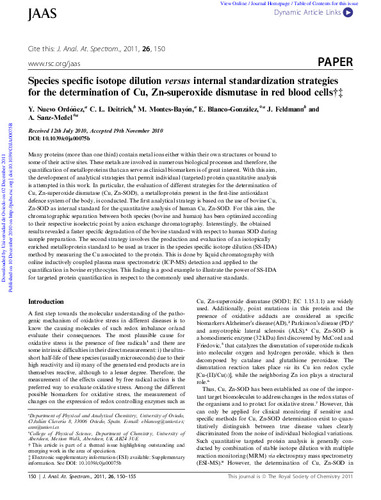Species specific isotope dilution versus internal standardization strategies for the determination of Cu, Zn-superoxide dismutase in red blood cells
Autor(es) y otros:
Fecha de publicación:
Versión del editor:
Citación:
Descripción física:
Resumen:
Many proteins (more than one third) contain metal ions either within their own structures or bound to some of their active sites. These metals are involved in numerous biological processes and therefore, the quantification of metalloproteins that can serve as clinical biomarkers is of great interest. With this aim, the development of analytical strategies that permit individual (targeted) protein quantitative analysis is attempted in this work. In particular, the evaluation of different strategies for the determination of Cu, Zn-superoxide dismutase (Cu, Zn-SOD), a metalloprotein present in the first-line antioxidant defence system of the body, is conducted. The first analytical strategy is based on the use of bovine Cu, Zn-SOD as internal standard for the quantitative analysis of human Cu, Zn-SOD. For this aim, the chromatographic separation between both species (bovine and human) has been optimized according to their respective isoelectric point by anion exchange chromatography. Interestingly, the obtained results revealed a faster specific degradation of the bovine standard with respect to human SOD during sample preparation. The second strategy involves the production and evaluation of an isotopically enriched metalloprotein standard to be used as tracer in the species specific isotope dilution (SS-IDA) method by measuring the Cu associated to the protein. This is done by liquid chromatography with online inductively coupled plasma mass spectrometric (ICP-MS) detection and applied to the quantification in bovine erythrocytes. This finding is a good example to illustrate the power of SS-IDA for targeted protein quantification in respect to the commonly used alternative standards.
Many proteins (more than one third) contain metal ions either within their own structures or bound to some of their active sites. These metals are involved in numerous biological processes and therefore, the quantification of metalloproteins that can serve as clinical biomarkers is of great interest. With this aim, the development of analytical strategies that permit individual (targeted) protein quantitative analysis is attempted in this work. In particular, the evaluation of different strategies for the determination of Cu, Zn-superoxide dismutase (Cu, Zn-SOD), a metalloprotein present in the first-line antioxidant defence system of the body, is conducted. The first analytical strategy is based on the use of bovine Cu, Zn-SOD as internal standard for the quantitative analysis of human Cu, Zn-SOD. For this aim, the chromatographic separation between both species (bovine and human) has been optimized according to their respective isoelectric point by anion exchange chromatography. Interestingly, the obtained results revealed a faster specific degradation of the bovine standard with respect to human SOD during sample preparation. The second strategy involves the production and evaluation of an isotopically enriched metalloprotein standard to be used as tracer in the species specific isotope dilution (SS-IDA) method by measuring the Cu associated to the protein. This is done by liquid chromatography with online inductively coupled plasma mass spectrometric (ICP-MS) detection and applied to the quantification in bovine erythrocytes. This finding is a good example to illustrate the power of SS-IDA for targeted protein quantification in respect to the commonly used alternative standards.
ISSN:
Identificador local:
20110084
DOI:
Colecciones
- Artículos [36354]
- Química Física y Analítica [610]
Ficheros en el ítem





